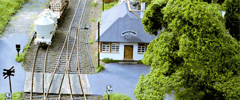Rules
- All tracks must be able to be used with wheel sets in accordance with NEM 310.
- The clearance in accordance with NEM 102/103 must be kept clear.
- In the visible area, the rail profiles are not higher than 1.4 mm (Code 55)
- The radii of the track curves are never less than 0.457 m.
- Switches must not rely on flange run-up.
Recommendations
- In the visible area, the rails are as high as possible, only 1.0 mm (Code 40).
- The curve radii in main tracks are at least 1.2 m.
- The radii in the continuous main tracks of the stations are at least 0.9 m.
- An expansion joint is installed every 0.5 m.
Large radii and slim switches not only look good, but also contribute to operational safety and reduce driving resistance. Of course, scaled radiuses [and switches] fail due to the space requirements, even in N-size. The following table shows this.
| Model radius | N-Radius | Note |
|---|---|---|
| 73 m | 0.457 m | Industrially offered branch track radius |
| 112 m | 0.7 m | Minimum radius on model tracks with 25 mm track spacing |
| 145 m | 0.9 m | Smallest model radius without special permission |
| 190 m | 1.2 m | Branch track radius of the prototype switch for 40 km/h |
| 300 m | 1.9 m | Branch track radius of the prototype switch for 50 km/h |
| 5000 m | 31 m | Minimum radius on new ICE routes |
It is therefore a painful compromise to allow radii of 0.9 m for main tracks.
The rails are 1.0 mm high (Code 40) to scale. For wheels according to NEM 310, they must be laid without small iron parts. Commercially available track material of this type is not yet encouraged. The only option is to build it yourself (key technique: soldering rails onto sleepers or sleeper grids made of circuit board material). This offers complete freedom for radii and switch shapes, but is not for everyone.
Fortunately, at least one manufacturer uses rails with a height of 1.4 mm (Code 55), imitates small iron parts, promises [implicitly] NEM-310 suitability, installs conductive frogs without flange run-up and makes the tracks quite stable through a special shape of the rail profile. If you accept tighter curves (see table above), you can also get curved switches. (The DKW and EKW in this program are not recommended.) The appearance and operational safety suffer only disproportionately - assuming the speed is adjusted - because the geometry and kinetics of the original and model switches differ. For the wiring of these switches, see Modul: Elektrik (Weichen).
There may be other manufacturers of suitable track material. In any case, there is no good reason to use higher rails, e.g. the common mass-produced products with a height of 2.0 mm (Code 80). Such material can only be installed in shadow stations.
To avoid damage due to thermal expansion or drying out, at least one expansion joint per module should be provided in the track; however, it must not be wider than 0.5 mm.
At the module head: Rules
- The tracks meet at right angles at the head piece (both in plan and elevation!). This can easily be checked with a mirror.
- An over-camber [of the outside rail of the curve] is not permitted.
- The rail ends are so well secured that they cannot be damaged during transport or assembly.
- The rails end about 0.2 mm in front of the edge of the module so that they are safely electrically separated there and are not subjected to any longitudinal force.
A reliable fastening of the rails to the module ends is necessary to avoid transport and assembly damage. For example, they can be soldered onto sawn-off brass screws or similar at the edge of the module.


